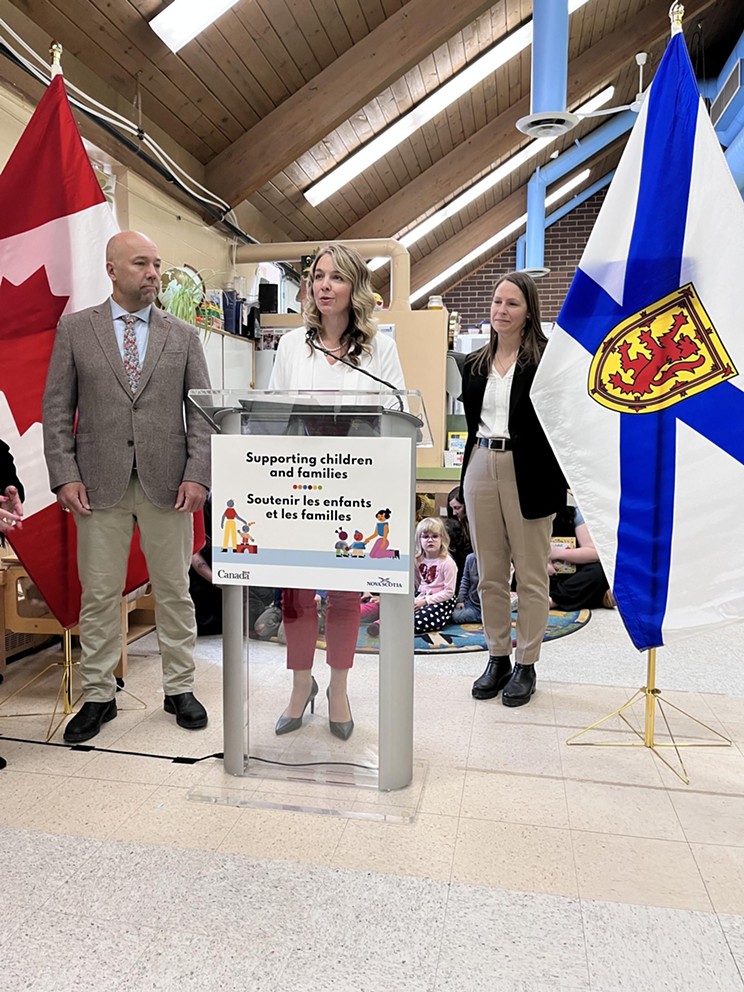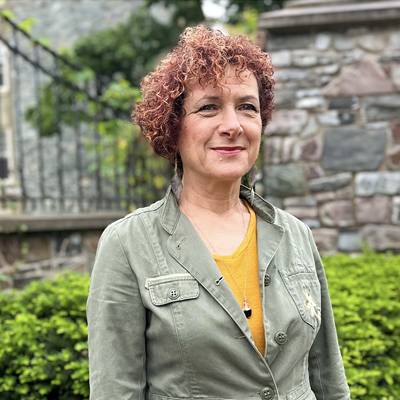Families are struggling to access child care in Nova Scotia. In 2021, one in two young children in Nova Scotia were living without adequate access to care, in what’s known as child care deserts. So, another 9,500 child care spots by March 2026 may sound like a lot—that’s what Nova Scotia and Ottawa promised to create as part of the Canada-Nova Scotia Canada-Wide Early Learning and Child Care Agreement spanning 2021 to 2026. Nova Scotia and Ottawa say they’ve created 3,861 new spaces as of Dec. 31, 2023. But spaces can't keep up with demand. In July 2023, Statistics Canada reported that Nova Scotia was home to 50,331 children under age 9. Daycare providers are managing waitlists in the triple digits and telling parents to apply to every centre they can in order to secure a space for their children.
Janessa Williams is the executive director at the Needham Early Learning Centre. They have space for 44 children at their centre on Devonshire Avenue and 30 at their expanded space up the road on Isleville Street. Yet their waitlist is nearly 500 names long. She says the Canada-Nova Scotia agreement has created “a perfect storm” of endless waitlists for child care in Nova Scotia. Demand is skyrocketing as families are able to afford child care for the first time with reduced fees, while more and more people move to Nova Scotia—specifically the peninsula.
As part of the 2021-2026 agreement, families in Nova Scotia have seen their child care fees reduced by an average of 50% towards the goal of $10/day care, on average, by 2026.
Yet there’s no adjustment to the total number of spaces agreed to in 2021’s agreement to accommodate that increased demand.
Early childhood educators—ECEs—will receive wage increases and access to group benefits and pension plans starting this spring.
Jenna Sudds, Canada’s minister of families, children and social development, says the new $3 per hour wage increase, plus access to group benefits for ECEs, “makes your province quite frankly the envy of many,” at the joint federal-provincial child care announcement Feb. 16 at the Needham in Halifax’s north end.
“Too often, early childhood educators get into the field because of their passion for working with children, but they leave because of the lack of recognition for the profession,” says Sudds. “We're changing that here in Nova Scotia, and across the country.”
Sudds and Becky Druhan, Nova Scotia’s minister of education and early childhood development, were at Needham to announce a three-year Action Plan for how they would be spending the remaining $440 million of the 2021-2026 child care agreement, including more than $105 million toward ECE compensations, retirement and health benefits.
Level 1, 2 and 3 ECEs will see their wages rise to between $22.91 and $28.78 by April 1, 2024–which still keeps many below the living wage rates for 2023 in Nova Scotia, apart from Cape Breton.
Williams took a leave from work last spring. Constantly telling parents and caregivers that Needham didn’t have space for their children became too much. Williams says it took her lot of therapy to get to a place where she knows it’s not her fault and to acknowledge, “I can only do what I can do within the means I have.”
“I'm in this profession because I care about children and families and I want every child to have the Needham experience–but they can't,” says Williams. “We're at a spot right now where, yes, we want to expand again. If the government gives us an opportunity, we will jump on it.
“But these different levels of government, from federal to provincial to municipal, need to work together. That's the only way–and I really don't feel that the municipality is working with the provincial government.” Williams says the municipalities have a lot of space that needs to be used and should be used to make child care truly accessible to all.
The three-year plan announced Feb. 16 will run out the remainder of the 2021 agreement and spend $52 million towards the creation of 9,500 new child care spaces for Nova Scotia. That number—9,500—was based on data available at the time, says Sudds, in response to whether that’s enough to match current demand. “Obviously, we’re seeing incredible growth here in Nova Scotia,” Sudds says, but calls the Canada-Wide agreement “an historic investment from the federal government with almost $30 billion that we put on the table [nation-wide] to develop this system.”
Nova Scotia’s population is experiencing rapid growth. As 2026 gets closer, Sudds says Canada will discuss how population growth is creating gaps in the action plan’s ability to adequately address the needs of families as “child care is a necessity–it’s not a luxury here in Canada.”
The three-year action plan is divided into five pillars of spending: affordability, access, quality, inclusion and administration. “With help from our federal partners…we now invest $277 million annually in early learning and child care,” says Druhan.“Parents don't know [about waitlists] until they start looking—and when they need the care, it's too late.”
tweet this
Says Sudds, “We're here announcing our $440 million of continued investment…to make sure that it’s accessible, regardless of where you are in Nova Scotia. It's important to drill that home– the action plan lays out these commitments to ensure that access is front and center, as we continue to work on all of the other pillars.”

The province knows there’s a child care problem–they assessed the lack of access in 2021 to determine criteria for accepting Expressions of Interests–EOIs–from centres wanting to expand. To access funding for ECE wages and parent fee reductions, regulated not-for-profit centres like Needham report on enrollment and waitlists every two weeks. However, the amount of families on waitlists province-wide isn’t publicly available.
Williams is now the director of two Needham centres since their first small expansion last July–and that was three years in the making. When the provincial government first rolled out funding initiatives in 2021, Williams submitted an EOI for expanding their centre. Their original proposal was accepted. That’s not been the issue. The issue has been finding space.
Needham hit several roadblocks in finding a place to lease–one wanted extremely high rent, another didn’t pass its environmental assessment, and a third couldn’t match their opening timeline. Finally, they found a place on Isleville Street for all 30 kids in their school-aged program and applied for a long-term lease from the city. Since then, Williams has been able to increase the licensing capacity at the original centre on Devonshire Avenue by 10 full-day preschool spaces last September. That meant “we were able to touch the waitlists for three families this year,” says Williams. That’s a very small fraction of families on their list.
Speaking with The Coast, Williams says there are 500 people hoping to get their child into Needham. “Our waitlist since 2021 has been creeping, creeping, creeping until now where it’s out of control,” says Williams. “Waiting lists are out of control at every centre.”
Expansion is necessary for child care to be accessible to every Nova Scotian who needs it. But it’s tough for directors of child care centres to manage the task of expanding without help from the city and the province. The province already owns buildings for public use and the city zones and leases buildings for public use or not-for-profits. Together they have extensive knowledge on available and appropriate sites for daycare expansions.
There’s a complex latticework of barriers when creating new child care spots within existing daycares, or expanding current centres to new locations. Daycares need to have enough trained staff and funding for their wages, adequate space that includes green space, administrative staff to support more families, and diverse and inclusive spaces that meet the needs of children and their families—including minority-language care, additional care needs, overnight care and infant care.
The recent Action Plan includes $30 million for equity, diversity, inclusion and accessibility-centred space creation, it says, however it’s unclear how the province is gathering and using data on diverse child care needs across communities. Both Druhan and Sudds point to a 2023 pilot-project that offers health care workers in Cape Breton overnight care for 12 kids. Provincial funding is crucial to offering diverse child care needs, but it’s still up to centres to ask for what they want.
Williams says, “I’ve had no bad partnerships or conversations with the government since that [2021 child care] transformation came into place,” because she’s advocated for her centre and its needs. Williams sits on the non-profit directors association that meets once a month. “I've taken the time to educate myself on government policy and how things work because the government is what the government is–and you can't bite the hand that feeds you.”
Community-based centres like Needham know the needs of their families and children, says Williams, and they should be supported to expand, by municipalities and the province working together to find usable space now. She hopes that’s the direction things are heading in.
She says the government has all the data they need to quickly expand child care where it’s needed most, through using spaces already set up for just that. For example, provincially-owned schools could open for school-aged care during the summer, says Williams. “There’s playgrounds, kitchens, bathrooms, classrooms. What’s the problem?”
Faculty unions have legitimate concerns with schools staying open during the summer, but Williams thinks there are ways to work with all parties involved. “Not every school would be needed,” she says.
Needham has existed for 30 years. Williams has been its executive director since 2012, and she says 2013 was the only year they advertised to families. “We had a Glow sign,” she says. “I always joke about that memory—we had a Glow sign and now it’s basically a sign that says ‘500 on our waiting list, keep driving!’
“Parents don't know [about waitlists] until they start looking—and when they need the care, it's too late.” Needham has a waitlist for their school-aged care this year, too, for the first time ever. Williams’ own children are affected by this.
“I have no space for my children for summer camp for the first time,” she says. “I can’t even bring them [to Needham] right now because there’s no space.
“I had to call my mom in Cape Breton and say, ’Are you taking a vacation because I might have to take my kids to you for a week.’ I've never had to do that before. I see that a lot more—children always with their grandparents because there's no care.”
Williams says part of the problem in finding solutions is that not everyone sees this as a crisis.
“The city's constantly hiring, but are you going to be able to hire someone that doesn't have child care? When does it get to that point that they say, ‘Okay, people need child care.’
“It's only those that need child care that see this crisis as a crisis.” Williams hears comments from people saying, “We don’t have kids—why are we paying for this?”
In response, Williams says “Who's going to take care of you in your nursing home? The children that we're raising right now.”
On Wednesday, Feb. 21, the province announced an end to waitlist fees—before this moratorium takes effect, parents could be charged up to $1,000 per child to stay on a for-profit daycare waitlist in case a spot opened up.
Amanda Reyes, a program facilitator at Needham, says she’s having brutally honest conversations with families who are looking for spaces, sometimes calling while they’re still pregnant. “I told her: 'You need to put yourself on every waiting list in the city that you can, especially if you’re looking for infant care',” says Reyes. “'I can’t tell you right now if you’re going to have a space or not, because you’re now number 328 on a waiting list.'”
Reyes herself doesn’t have before-and-after care for her son who will enter pre-Primary in the fall. Before-and-after school programs—BAPs—aren’t regulated the same way not-for-profit child care is. Unregulated BAPS cost more, won’t likely receive parent fee reductions and usually pay their workers less than licensed daycares.
Even ECEs, who are part of the wage-increase announced to take effect this spring, are earning $15-18 an hour when they work at BAPs, compared to the new wage for Levels 1-3 ECEs which is just under $23. Some BAP programs, which are tough to get into in the first place, are asking $40 a day which Reyes can’t afford. Both her parents work full time, so they can’t take care of her son before 9am or after 3pm, when school will run. “I know I can't pay $40 a day. So, that's not an option.
“It's an option, but it's not an option. It's too much money.”













